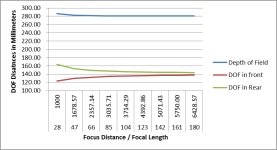Warning: This post uses numbers and math and I don't always 'splain things the best. It could have an adverse effect on life in general. Turn back now or proceed at your own risk.

Been playing with the numbers some more, just to see, because quite frankly, this is one of those things that is difficult to visualize without some kind of picture aid. So using @
STM 's idea from above, I created the chart below that compares Total DOF as well as the front portion and rear portion using f/5.6 and 28mm focal length at a focus distance of 1 meter and then calculating a focus distance to achieve the same magnification at a focal length of 180mm. Plotted interim focal length/distance combinations to add to the visual aid.
Based on a DX sensor size, the total DOF at a focal length of 28mm is 286.16mm and the DOF at a focal length of 180mm (at roughly the same magnification) is 280.67mm for a difference of 5.49mm.
Being fair to @
STM if a shorter focal length were stated like 20mm, the difference in DOF jumps to roughly 45mm and at a focal length of 10mm the difference jumps to roughly 245mm. So, even at the same magnification, moving toward ultra-wide angle increases the DOF. Also, the difference in DOFs will increase if the starting focus distance is increased; if the subject size is larger, the DOF's will have a greater difference.
Caution: I'm kind of lazy when it comes to triple checking numbers and I am relying on equations from the webernet, so would advise anyone to whip out their DOF calculator or table and compare the results to the table below the chart. Better yet, use a camera and zoom to make a real life comparison.
DOF in Front means the depth of field that extends toward the camera from the focus point.
DOF in Rear means the depth of field that extends away from the camera behind the focus point.

Here are the calculated values that generated the chart lines.
| Focal Length | 28 | 47 | 66 | 85 | 104 | 123 | 142 | 161 | 180 |
| Depth of Field | 286.16 | 282.51 | 281.53 | 281.13 | 280.93 | 280.82 | 280.75 | 280.70 | 280.67 |
| DOF in front | 123.01 | 129.45 | 132.39 | 134.07 | 135.16 | 135.93 | 136.49 | 136.93 | 137.27 |
| DOF in Rear | 163.15 | 153.06 | 149.14 | 147.06 | 145.77 | 144.89 | 144.26 | 143.77 | 143.40 |




